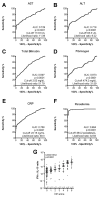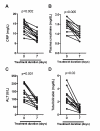Severe Plasmodium vivax malaria exhibits marked inflammatory imbalance
- PMID: 20070895
- PMCID: PMC2837053
- DOI: 10.1186/1475-2875-9-13
Severe Plasmodium vivax malaria exhibits marked inflammatory imbalance
Abstract
Background: Despite clinical descriptions of severe vivax malaria cases having been reported, data regarding immunological and inflammatory patterns are scarce. In this report, the inflammatory and immunological status of both mild and severe vivax malaria cases are compared in order to explore immunopathological events in this disease.
Methods and results: Active and passive malaria case detections were performed during 2007 in Buritis, Rondônia, in the Brazilian Amazon. A total of 219 participants enrolled the study. Study individuals were classified according to the presence of Plasmodium vivax infection within four groups: non-infected (n = 90), asymptomatic (n = 60), mild (n = 50) and severe vivax infection (n = 19). A diagnosis of malaria was made by microscopy and molecular assays. Since at present no clear criteria define severe vivax malaria, this study adapted the consensual criteria from falciparum malaria. Patients with severe P. vivax infection were younger, had lived for shorter time in the endemic area, and recalled having experienced less previous malaria episodes than individuals with no malaria infection and with mild or asymptomatic infection. Strong linear trends were identified regarding increasing plasma levels of C reactive protein (CRP), serum creatinine, bilirubins and the graduation of disease severity. Plasma levels of tumour necrosis factor (TNF), interferon-gamma(IFN-gamma) and also IFN-gamma/interleukin-10 ratios were increased and exhibited a linear trend with gradual augmentation of disease severity. Both laboratory parameters of organ dysfunction and inflammatory cytokines were reduced during anti-parasite therapy in those patients with severe disease.
Conclusion: Different clinical presentations of vivax malaria infection present strong association with activation of pro-inflammatory responses and cytokine imbalance. These findings are of utmost importance to improve current knowledge about physiopathological concepts of this serious widespread disease.
Figures




References
-
- da Silva J. , Jr. National System in Health Surveillance: situation report: Rondônia. Brasília: Ministério da Saúde; 2006. p. 24.
-
- Alves FP, Durlacher RR, Menezes MJ, Krieger H, Silva LH, Camargo EP. High prevalence of asymptomatic Plasmodium vivax and Plasmodium falciparum infections in native Amazonian populations. Am J Trop Med Hyg. 2002;66:641–648. - PubMed
-
- Ladeia-Andrade S, Ferreira MU, de Carvalho ME, Curado I, Coura JR. Age-dependent acquisition of protective immunity to malaria in riverine populations of the Amazon Basin of Brazil. Am J Trop Med Hyg. 2009;80:452–459. - PubMed
Publication types
MeSH terms
Substances
LinkOut - more resources
Full Text Sources
Research Materials
Miscellaneous

